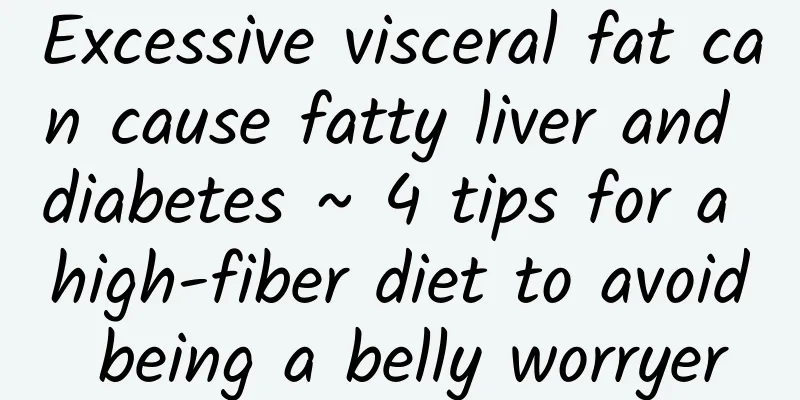Excessive visceral fat can cause fatty liver and diabetes ~ 4 tips for a high-fiber diet to avoid being a belly worryer

|
Ladies who have tried all kinds of ultimate weight loss methods, do you still believe that all fat is evil? Or are you very concerned about the floss-like fat on your hips, thighs and arms and want to get rid of it as soon as possible? Wait a minute, now I will reveal the secret of fat. In fact, with some fats, the less you have, the better; with other fats, the more you have, the better. Forget the number on the scale; the real target is your visceral fat. Fatty liver and diabetes are related to it. If you don’t want to be a “belly worryer”, you must quickly get rid of visceral fat! From liver cleanses to bean cleanses, compression garments to Lycra, low-calorie diets to enemas, and portion control to paleo, new weight-loss trends are popping up faster than sautéed kale. However, 95 percent of people who try to lose weight, no matter which method they use, gain it back within 12 months and are even fatter than before. Is fat evil? First, understand the roles of different fats Is fat all evil? The answer may be very different from what you think! Helena is a doctor and a brain expert. Helena Popovic, in her new book, "Your Brain Wants You to Be Thin," says there are two main forms of fat tissue in the body: white (WAT) and brown (BAT). Brown fat is healthy, it keeps you warm and increases your metabolic rate, so the more the better. However, white fat can cause health problems if too much of it accumulates in and around the body's organs. This area of fat is called visceral fat (VAT), so the less the better. Two more types of fat cells have recently been discovered ("beige fat," or "brite," a portmanteau of BROWN in whITE, and "pink fat"). However, these two types of fat cells are much less abundant in the body than white and brown fat, and their roles are still unclear. White fat is found in two distinct places: just beneath the skin (subcutaneous fat, or SWAT) and around your internal organs (visceral fat, or VAT): ⊙Subcutaneous fat: The function of subcutaneous fat is to store energy, keep the body warm and isolate it from wind and cold. Subcutaneous fat can be found all over the body, including the buttocks, thighs, arms, back, abdomen, and even the soles of the feet. Subcutaneous fat is thickest on the buttocks, palms of the hands, and soles of the feet. Subcutaneous fat is not harmful to health. A study of obese women published in the New England Journal of Medicine in 2004 showed that removing more than 10 kilograms (22 pounds) of subcutaneous fat through liposuction did not bring any health improvements, including no changes in blood pressure, triglycerides, or blood sugar levels. 《Tip》: You don’t need to worry about fat that shakes. ⊙Visceral fat: Visceral fat, on the other hand, is located deep in the abdominal cavity and surrounds the internal organs: the heart, liver, pancreas, kidneys, intestines, ovaries and uterus, and is also stored in the internal organs. Visceral fat is invisible to the naked eye, and a person may be classified as a "normal" weight but still have considerable visceral fat. People with excessive visceral fat are known as "belly worriers", which can lead to cardiovascular disease, fatty liver, type 2 diabetes, and even Alzheimer's disease. Getting rid of that little bit of wobbly tissue under your arms won't improve your health, but removing the hidden fat around your internal organs can add more than a decade to your life. A study of older women published in Circulation: Journal of the American Heart Association found that visceral fat has a more decisive impact on cardiovascular disease than overall excess obesity. Getting rid of visceral fat doesn’t require expensive medications or newfangled treatments. 《Tip》: 4 effective ways to reduce visceral fat: 1. Regular exercise: Even a 30-minute walk every day can make a positive difference. 2. Get adequate sleep: at least 6 hours a night, 7 to 9 hours is better, depending on your personal needs. 3. Reduce stress: Chronic stress hormone cortisol can cause fat to accumulate in the abdomen. 4. High-fiber, whole-food diet: It is a "diet method" rather than a calorie restriction. In addition, two hormones produced by white fat have a significant impact on health and health-related behaviors: adiponectin and leptin. ⊙Adiponectin: Adiponectin makes the liver and muscles sensitive to insulin, a hormone produced by the pancreas that promotes the movement of glucose (sugar) from the blood into the muscles, liver, and fat tissue itself. If the liver and muscles become resistant to insulin, glucose will remain at high concentrations in the blood, causing systemic damage. Therefore, adiponectin increases the body's sensitivity to insulin, thereby protecting us from diabetes and heart disease. ⊙ Leptin: Leptin, often referred to as the "satiety hormone," also helps regulate inflammation. Leptin is primarily produced and secreted by adipose tissue, but is also produced in the stomach, liver, skeletal muscle, placenta, ovaries, and bone marrow. After each meal, when fat is stored to a certain amount, white fat and brown fat begin to produce leptin. It travels to the hypothalamus in the brain, where it reduces sensitivity to hunger and increases the desire to consume energy. That’s why doctors want to find ways to control it: Leptin not only reduces hunger, it also makes us want to exercise! In addition to the production of leptin depending on meal times, its concentration also has a fixed cycle every day. The leptin concentration in the blood is highest between midnight and 6 a.m., probably because it allows us to sleep well and not feel hungry. Because leptin is produced by adipose tissue, obese people tend to have higher leptin levels in their bodies. 【3 NG situations that affect leptin】 Three factors can reduce a person's sensitivity to leptin, so that they no longer feel full, either during or after a meal: 1. Lack of physical exercise. 2. Continuously ignoring satiety cues, for example, by mindlessly eating in front of the TV. 3. Insulin levels are too high, resulting in insulin resistance and symptoms of type 2 diabetes. In addition, some special conditions can affect the production of leptin, including: ●After fasting for 12 to 72 hours, leptin will decrease, stimulating us to eat. ●Sleep deprivation reduces leptin production, increases hunger, and stimulates our craving for fatty and sugary foods. Brown fat contains structures called mitochondria, which are the source of energy production (calorie burning). Mitochondria contain iron, which is why they are brown. Compared to overweight or obese people, lean people tend to have more brown fat, which burns calories when it is "stimulated." So scientists are very excited to try to find ways to increase brown fat and activate it. When brown fat is stimulated, what does it do? 1. Brown fat increases your metabolic rate. 2. Brown fat helps control blood sugar by extracting glucose from the blood. 3. Brown fat improves insulin sensitivity. 4. Brown fat removes triglycerides from the blood, thereby reducing the risk of heart disease, stroke and diabetes. This is what needs to happen to reverse the health damage caused by excess visceral fat. No wonder everyone wants more brown fat! Until now, the only known way to increase brown fat is to spend long periods of time in low temperatures and to engage in regular exercise. |
Recommend
What are the treatments for female cervicitis?
What are the treatments for female cervicitis? In...
Doctors do not recommend taking a shower directly after an abortion. There are two things you should pay attention to when taking a shower after an abortion.
You cannot take a shower immediately after an abo...
Increased vaginal discharge is a common clinical manifestation of cervical erosion
With the development of society, women are under ...
Care after surgery for Bartholinitis
Bartholinitis is a common gynecological disease. ...
What are the symptoms of cervicitis in women? 3 early symptoms of cervicitis should be taken seriously
Cervicitis is a gynecological disease that often ...
Skipping breakfast to lose weight? Instead of reducing it, the risk of diabetes and hypertension increases!
Many people always tell themselves to eat less as...
What are the prevention methods for vaginitis?
The occurrence of vaginitis has brought unspeakab...
What should we pay attention to when it comes to cervical erosion?
What should we pay attention to when it comes to ...
What does cervical nabothian cyst mean?
Cervical nabothian cysts usually refer to a commo...
Early detection of cervicitis symptoms can help patients
Cervicitis is a very common gynecological disease...
Explain the common manifestations of the hazards of painless abortion
In our lives, there are more and more women who a...
Factors that cause ectopic pregnancy in women
Ectopic pregnancy is common in life, and many peo...
What should I do if I have back pain after ectopic pregnancy surgery?
What should I do if I have back pain after ectopi...
Remove oil and grease! Aloe vera and Tremella soup moisturizes and cleanses the intestines
Aloe vera is a common plant that can not only be ...
What are the sequelae of habitual miscarriage?
Habitual abortion is very harmful to women's ...









